 |
|
|||
 |
 |
|||
RINKER ON COLLECTIBLES — Column #1757 Copyright © Harry Rinker, LLC 2020 Questions
and Answers
QUESTION: I recently went to an estate sale in Corpus Christie, Texas, on a Saturday when everything was discounted 50 percent and purchased a drop leaf table that was being used to display material being offered for sale. I looked under the table and saw a burnt brand mark reading “OLD HICKORY / MARTINSVILLE / INDIANA.” The table was priced at $200.00. I bought it for $100.00. The round, drop leaf, slat boards top measures 56-inches in diameter. The table stands 28-inches high. The boards beneath the table supporting the slat boards are secured with Phillips screws. The hickory legs are an “X” style with casters. I searched the internet and discovered I purchased a 1950s Old Hickory barbecue table. Did I pay a fair price? – SV, TX, Email Question 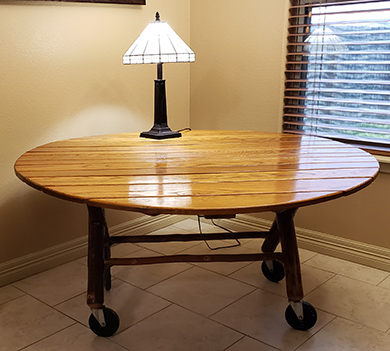
ANSWER: Today’s young collectors are brand conscious. They pay a premium for brand named products. They fail to understand that many brands went through periods of greatness and decline. Brand name alone is not enough to guarantee investment dollars. Jeff Cherry and Kass Hogan, owners of Cherry Gallery (www.cherrygallery.com), in Damariscotta, Maine, have an article on their website entitled “Defining and Identifying Old Hickory vs. Hickory Furniture” (https://www.cherrygallery.com/journal-posts/defining-and-identifying-old-hickory-vs-hickory-furniture). They divide the production history of the Old Hickory Furniture Company of Martinsville, Indiana, into four periods: (1) Old Hickory Chair Company; (2) Old Hickory Furniture Company, early years (1920s and 1930s); (3) Old Hickory Chair Company, middle years (1940s); and (4) Old Hickory Furniture Company, final era (1950s). Cherry and Hogan’s article includes an illustration of a 1950s Old Hickory Furniture Company barbecue table that is identical to the one that you bought. The burnt brand mark illustrated for the final era in the Cherry and Hogan article does not correspond to the one found on your table. The mark is closer to the 1940s brand mark illustrated in the Cherry and Hogan article. Old Hickory Furniture Company did not change its brand mark every ten years to celebrate the beginning of a new decade. Older brand marks were used simultaneously with newer brand marks. Phillips screws were in use by the 1940s, albeit their use in your table suggests a 1950s origin as opposed to an early 1940s origin. 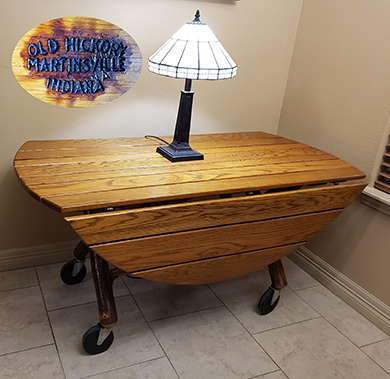
I carefully researched your 1950s Old Hickory Furniture Company barbecue table on WorthPoint.com and other internet pricing websites. I did not find an exact match. This does not indicate the table is scarce but rather there is no strong secondary market for it. Old Hickory Furniture Company collectors prefer pre-1940 examples. They have little interest in the post-1945 products. As a result, prices for post-1945 Old Hickory Furniture Company pieces are driven by reuse/functional rather than collector value. The $200.00 asking price for your table was a fair secondary market retail value. $100.00 was a great price. Use the table and enjoy it. Do not think of it as an investment. It is not now nor is it likely to be in the future. QUESTION: I have a pair of Pompeian Bronze Co. lamp standards. They stand 16 1/4-inches high. The base is 8-inches wide. The painted base has a Moorish building theme with a seated Arabic-dressed figure in each of the four quadrants separating the base legs. My mother told me that these were torchieres from the Algonquin Hotel in either Illinois or Wisconsin and that they originally had black pierced metal, half-moon shades depicting women in harem style clothing. Do they have any value? – EC, Palm Harbor, FL, Email Question 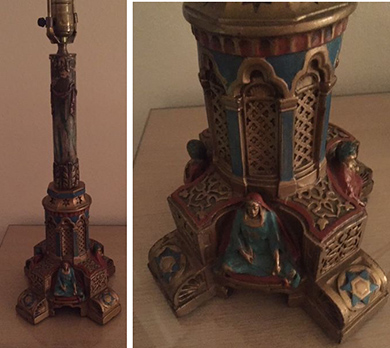
ANSWER: The Pompeian Bronze Works traces its history back to the Galvano Bronze Company, a New York City firm founded by Paul Mori around 1899. Galvano Bronze was one of the first American commercial companies to use bronze electroplating and electroforming. It introduced bookends into its product line in 1915. In the early 1920s, the Galvano Bronze Company was sold to its employees and became The Pompeian Bronze Works. Peter Manfredi, an employee, filed 27 book and lamp design copyrights with the U. S. Library of Congress Copyright Office in 1921. The company continued using the bronze electroplating (bronze-clad) and electroforming using white-metal (often pewter) or spelter (zinc) to make ashtrays, bookends, and lamps. In addition to a bronze finish, the company painted some of its products. Scholars are not able to agree upon the end date for the company. In the 1920s, Europe and North America became fascinated with the Middle and Far East. “The Sheik” starring Rudolph Valentino and Agnes Averes was released in 1921. Jazz Age textiles were heavily influenced by the Exoticism of Asia and the Middle East. Exoticism went out of fashion with the arrival of the Modernist era. Collector interest in your lamp bases is minimal. Interest would increase if you were able to find interior pictures featuring the torchieres from a hotel. The missing shades represent over 75 percent of the lamps’ potential value. The Pompeian Bronze Works lamp bases have a secondary collector value between $85.00 and $100.00 for the pair. The value would double if you can find a decorator with the ability to recreate the period shade or a viable substitute. P.S.: There is a flaw in your story. The only Algonquin Hotel I could find was and is in New York City. Is it possible your mother meant a hotel located in Algonquin, Illinois? t QUESTION: I have a license plate that reads: “ALABAMA/ NATIONAL / CHAMPS / 61-64-65” and has a picture of an elephant’s head with its trunk wrapped around a “1” in the lower left quadrant. No one I talked with has been able to give me any information about its rarity or worth. Can you shed some light on my dilemma? – HD, Bay Minette, AL, Email Question 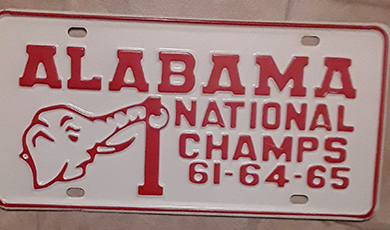
ANSWER: First, this is a souvenir license plate as opposed to a state-issued license plate. Second, there are multiple variations of this license plate with added dates as Alabama won additional national football championships. Third, the value has a narrow focus – Alabama football fanatics. No self-respecting Auburn fan would be caught dead displaying the souvenir license plate on his/her car. Examples of your license plate appear for sale on eBay on a regular basis. WorthPoint.com lists an example closing at $50.00 on June 13, 2018 and one at $55.00 on November 11, 2017. As always, I recommend taking a conservative approach to value. A fair secondary market value, but only to an Alabama football fan, is between $35.00 and $45.00. ount is alw QUESTION: I have been following “Rinker on Collectibles” for years. Recently, I purchased an unusual, three-dimensional, wooden cat bird feeder at a yard sale in Pittsburgh. It is approximatey 20-inches long. Although heavily weathered, it is in great shape for its age. I would like to know more about the piece. Can you help? – PMcE, Pittsburg, PA, E-mail Question 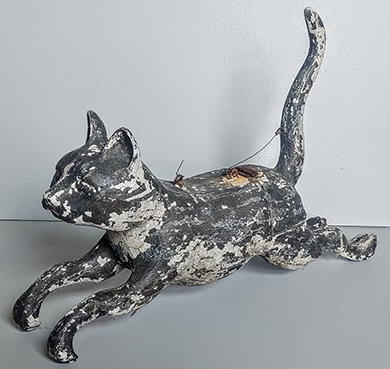
ANSWER: Basement workshop project collectibles amuse me. Having grown up with uncles whose basements included band and table saws, drill presses, sanding machines, lathes and a host of other metal and wood working machines (even my own father was not immune), I continually wonder what happened to all the products that emanated from those basements. I rest content in the knowledge that most of it has been lost to posterity. I am not certain that I would use “great shape” to describe your wooden cat bird feeder. My personal condition evaluation suggests it looks as though it has been through several world wars. A WorthPoint.com search of “wood cat bird feeder” did not result in anything that looked remotely like the example you own. Nor did a Google search using the same parameters. You did not share what you paid for the bird feeder. If you bought it at a yard sale, I suspect under $50.00. As everyone involved in the antiques and collectibles trade knows, value is in the eye of the beholder. While I would never claim the piece is American folk art, there are those in that community who will. To these individuals, value will range in the low to middle hundreds of dollars. In the cat collecting community, a value between $75.00 and $100.00 makes sense. The decorate value is somewhere in between these two values. One final note: Do not restore it, that is to say, repaint it. Its weathered look adds to its appeal. Harry L. Rinker welcomes questions from readers about
collectibles, those mass-produced items from the twentieth and twenty-first centuries.
Selected letters will be answered in this column.
Harry cannot provide personal answers.
Photos and other material submitted cannot be
returned.
Send your questions to: Rinker on Collectibles, 5955 Mill
Point Court SE, Kentwood, MI 49512.
You also can e-mail your questions to
harrylrinker@aol.com.
Only e-mails containing a full name and mailing address
will be considered.
|
||||